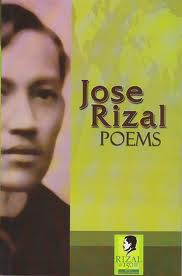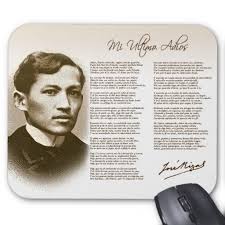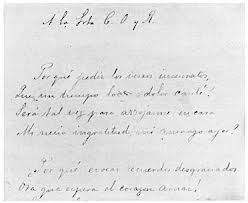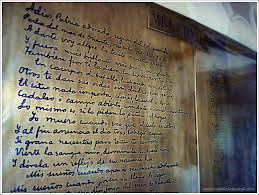Sponsored Links
Jose Rizal’s Poems
 Jose Rizal’s Poems
Jose Rizal’s Poems
© 2013 by Jensen DG. Mañebog
“The Filipinos forgot their writings, their songs, their poetry, their laws in order to learn by heart other doctrines, which they did not understand.”
- JOSE RIZAL
ONE WAY TO GAUGE a person’s life is to look at his works and writings. Poetry reveals an individual’s thoughts, hopes, dreams, aspirations, and even heartaches. The genius in Jose Rizal, our national hero, had resulted in several poems during his childhood, schooling, life struggles, and right before his martyrdom. Let us take a peek at our national hero’s poetry. (For Rizal’s poems themselves, please see “Jose Rizal’s Poems: A Compilation” through the search engine of www.OurHappySchool.com).
Refer these to your siblings/children/younger friends:
HOMEPAGE of Free NAT Reviewers by OurHappySchool.com (Online e-Learning Automated Format)
To see how our MODERN ELearning Reviewers work, please try this 5-item sample:
An Open Letter to School Principals, Teachers, and Parents
My First Inspiration (Mi Primera Inspiracion, 1874)
Most likely, “Mi Primera Inspiracion” was the first poem Jose Rizal had written during his stint at Ateneo. This poem was written in honor of his mother’s birthday as suggested by the terms “perfume of the flowers”, “the songs of the birds”, “feast your day of bloom” and “festive day”.
Jose Rizal’s poetic verses show his eternal love and appreciation for his mother. This was somewhat his way of paying tribute to all the efforts for him of her dear mother.
Felicitation (Felicitacion, 1875)
The poem “Felicitation” was written by the hero in 1875 during his schooling in the Ateneo de Municipal. The 14-year old Rizal wrote this poem to congratulate his brother-in-law, Antonio Lopez, husband of his sister Narcisa.
The Embarkation, A Hymn to Ferdinand Magellan’s Fleet (El Embarque: Himno A La Flota De Magallanes, 1875)
Rizal wrote this poem while he was a boarding student at the Ateneo Municipal de Manila. It was believed to have been his first poem that had the honor of being read in a public program held at that school. “Hymn to Magellan’s fleet”talked about the departure of Ferdinand Magellan, the first man to colonize the Philippines.
And He Is Spanish: Elcano, The First To Circumnavigate The World (Y Es Espanol: Elcano, El Primero En Dar La Vuelta Al Mundo, December, 1875)
This poem is about Juan Sebastián Elcano, a Spanish Basque, Ferdinand Magellan’s second in command, who upon Magellan’s death on the shores of Mactan in the Philippines, took over and completed the first circumnavigation of the world.
The Battle: Urbiztondo, Terror of Jolo (El Combate: Urbiztondo, Terror De Jolo, December 1875)
The poem is a reflection of Rizal’s liking for history. It was written to hail Urbiztondo for the successful battle against the Muslims. In the poem, the hero narrated how the great warrior defeated the Moros under Sultan Mahumat of Jolo.
The Tragedy of St. Eustace (La Tragedia De San Eustaquio, June 1876)
This poem recounts the tragic story of St. Eustace. The original manuscript of this poem no longer exists however as it may have been destroyed during the WWII bombings. Nonetheless, the poem had been published in installments in a magazine, “Cultura Social” of the Ateneo.
 In Memory of My Town (Un Recuerdo A Mi Pueblo, 1876)
In Memory of My Town (Un Recuerdo A Mi Pueblo, 1876)
Rizal loved his hometown Calamba in Laguna. He fondly remembered his memories of the said town. In 1876, Rizal as a 15-year old student in the Ateneo Municipal de Manila wrote the poem “In Memory of My Town”. It was written to express his love and appreciation for the place where he grew up.
Intimate Alliance Between Religion and Good Education (Alianza Intima Entre La Religion Y La Buena Educacion, 1876)
Jose Rizal believed that religion and good education go together. Believing that there is a strong relationship between academics and faith, he wrote the poem “Intimate Alliance between religion and good education” at the age of fifteen while he was in Ateneo.
Education Gives Luster To The Motherland (Por La Educacion Recibe Lustre La Patria, 1876)
Our national hero, despite his young age, had expressed high regards for education. He believed in the significant role education plays in the progress and welfare of a nation as evident in his poem “Education Gives Luster to the Motherland”.
Rizal believed that education gives knowledge, knowledge gives wisdom, and that great wisdom benefits everyone. Considering that education is a vehicle for a country’s prosperity and success, he encouraged the Filipinos through the poem to acquire education for them to be able to fulfill their dreams and to improve their motherland. His high regards for education was manifested in his determination to seek the best education possible even across the shores of his country.
The Captivity and the Triumph: Battle of Lucena and the Imprisonment of Boabdil (El Cautiverio y el Triunfo: Batalla de Lucena y Prision de Boabdil, December 1876)
At 12 years of age, Rizal was believed to have read “El Ultimo Abencerraje,” a Spanish translation of Chateaubriand's novel, “Le Dernier des Abencérages.” This is the story of the last member of a famous family in the Muslim Kingdom of Granada in the 15th century, which later inspired Rizal to compose “The Captivity and the Triumph: Battle of Lucena and the Imprisonment of Boabdil” while studying in Ateneo. In this poem, he described the defeat and capture of Boabdil, last Moorish sultan of Granada.
Triumphant Entry of The Catholic Monarchs Into Granada (Entrada Triunfal De Los Reyes Católicos En Granada, December 1876)
This poem of Jose Rizal relates the triumphant entry of Ferdinand and Isabella, Spain’s “Most Catholic Kings,” into the city of Granada in 1492. This entry is one of the most powerful symbolic moments in Spanish history.
The Heroism of Columbus (El Heroismo De Colon, 1877)
Jose Rizal wrote this epic poem in December 1877 during his academic years in Ateneo Municipal de Manila. This poem praises Columbus, the discoverer of America.
Columbus and John II (Colon y Juan II)
This poem relates how King John II of Portugal missed fame and riches by his failure to finance the projected expedition of Columbus to the new world.
Great Solace in Great Misfortune (Gran Consuelo En La Mayor Desdicha, 1878)
This is a legend in verse of the tragic life of Columbus, the person credited for discovering America.
A Farewell Dialogue of the Students (Un Dialogo Alusive A La Despedida De Los Colegiales)
This was the last poem written by Rizal in Ateneo which again amazed his teachers. It was a poignant poem of farewell to his classmates, written just before he graduated from the Ateneo.
Child Jesus (Al Nino Jesus, November 1875)
During his student days, the 14-year old Jose Rizal wrote “Al Niño Jesus” (Child Jesus), a brief religious ode which expressed his devotion as a child to Catholicism.
To the Virgin Mary (A La Virgen Maria, To Our Lady of Peace and Good Voyage)
This undated poem was another religious writing Jose Rizal wrote in praise of the Virgin Mary, the mother of Jesus Christ.
To The Philippine Youth (A La Juventud Filipina, November 1879)
This was a winning poem in 1879. Rizal submitted it as his entry to the literary contest held by the ‘Liceo Artistico-Literario’ (Artistic-Literary Lyceum) of Manila—a society of literary men and artists. Written by Rizal at the age of eighteen, this artwork which was said to be of flawless form aimed to implore the Filipinos to rise from indolence. It is deemed a classical piece of Philippine literature for reasons that (1) Spanish literary authorities recognized it as an impressive poem written in Spanish by a Filipino and (2) it was the foremost literary piece to display the nationalistic belief that Filipinos were the “fair hope of the Fatherland.”
Abd-El-Azis and Mohammed (Abd-El-Azis Y Mahoma, December 1879)
This epic poem was written by Jose Rizal in 1879 and declaimed by a certain Manuel Fernandez on the night of December 8, 1879 in honor of the Ateneo’s Patroness. It recalls the struggle between the Spaniards and the Moors in Spain.
ThePhilippines, February 1880
This very nationalistic poem was written by Jose Rizal to serve as a reminder for Filipinos to love their motherland.
Al M.R.P. Pablo Ramon, 1881
Jose Rizal truly loved his alma mater Ateneo as well as his professors. He wrote a poem for one of them, ‘Al M.R.P. Pablo Ramon’, a lovely tribute to the Very Reverend Pablo Ramon, Rector of the Ateneo, who had been so kind and helpful to the national hero. The poem was written on the occasion of the rector’s birthday.
Goodbye to Leonor, 1882
Leonor was only 13 years of age when she first met Jose Rizal. Due to the strong disapproval of Leonor’s parents of their love affair, they kept in touch by sending letters and photographs to each other. This poem was the one Rizal wrote for Leonor as he left for Spain in 1882.
They Ask Me for Verses (Me Piden Versos, October 1882)
Rizal had been a member of Circulo Hispano-Filipino (Hispano-Philippine Circle), a society of Spaniards and Filipinos in Madrid. In the New Year’s Eve reception of the Madrid Filipinos held in 1882, he declaimed his written “Me Piden Versos”, a poem he wrote due to the request of the society’s members. In March 31, 1889, this poem was published in the La Solidaridad.
 To Miss C.O. y R., 1883
To Miss C.O. y R., 1883
Jose Rizal, though not really a handsome man in today’s perspective, attracted ladies easily. Perhaps his exceptional talents and charisma made him attractive to women. Furthermore, his gift of poetry made him even more likable. He composed a poem entitled “To Miss C.O. y R” to express his admiration to Consuelo Ortiga y Perez, the beautiful daughter of Don Pablo Ortiga y Rey. Nevertheless, he did not pursue his feelings for her due to the fact that he was still engaged to Leonor Rivera then and his friend, Eduardo de Lete, had serious feelings for Consuelo.
The Flowers of Heidelberg (A Los Flores De Heidelberg , April 1886)
At some points in his life, Jose Rizal stayed in Heidelberg, a city in the state of Baden-Württemberg in Germany. In 1887, the 25-year old Rizal completed his eye specialization under the renowned Prof. Otto Becker in the University of Heidelberg. In spring, flowers bloom along the banks of Neckar River. Rizal admired particularly the light blue spring flower “forget-me-not”. These beautiful flowers made him think of their flowers in Calamba. Amid his homesickness in the spring of 1886, he came up with this nice poemwhich expressed prayer for the wellbeing of his native land.
The Song of Maria Clara, 1887
This poem forms part of the Jose Rizal’s first novel, Noli Me Tangere. In the novel, one of the main characters, Maria, upon the insistent requests of her friends, rendered a beautiful song with the accompaniment of the harp.
Hymn To Labor, 1888
Jose Rizal wrote the poem “Himno Al Trabajo” before he left Calamba in 1888. This poem was in response to the request of his friends from Lipa, Batangas. They wanted a hymn to commemorate the elevation of Lipa from a town to a city in January 1888. Dedicated to the industrious folks of Lipa, the poem consisted of lyrical conversations of men, wives, maidens and children.
To My Muse (A Mi, 1890)
It was against a background of emotional agony in Brussels, during those sad days when he was worried of family disasters, that Rizal wrote his emotional poem, “A Mi” (To my Muse).
Kundiman, 1891
The word “kundiman” connotes a traditional Filipino love song usually used by a man to serenade a woman being wooed. Rizal’s “Kundiman” was a poem expressing his intense love for his motherland. In the verses, we can see that Rizal is optimistic that the Philippines would be freed from inequality and oppression.
Water and Fire (El Agua Y El Fuego, 1891)
This is a very short composition excerpt from the novel El Filibusterismo, Chapter ‘El Cubierta’. In this poem, Jose Rizal expressed his great dream for the Philippines: its freedom and advancement.
To Josephine, 1895
Rizal dedicated this poem to an Irish woman, Josephine Bracken, whom he called (in another poem) his “dulce extranjera” (sweet foreigner).When Josephine temporarily left Dapitan to accompany Taufer to Manila, Rizal gave her this short poem which manifested that he was really “smitten” with Josephine.
Hymn To Talisay, October 1895
Rizal conducted his school at his home in Talisay, near Dapitan, where he had his farm and hospital. He frequently met with his boys underneath a talisay tree. This poem, which was written for his pupils to sing, also taught them how to fight for their rights. The poem speaks about the place Talisay and Rizal’s serene life in exile.
My Retreat (Mi Retiro, 1895)
Upon the request of Doña Teodora, Jose Rizal came up with a beautiful poem vis-à-vis his tranquil life in Dapitan. The poem, which was entitled “Mi Retiro” (My Retreat), was sent to his mother in 1895. It was commended by the critics as one of the best of his literary creations.
In the poem, he gave a narrative account of his peaceful life while exiled in Dapitan where he lived a well-rounded life as a farmer, teacher, and a merchant.
Song of the Wanderer/Traveler (El Canto Del Viajero, 1896)
Rizal’s friend Blumentritt once advised Jose Rizal, an exile in Dapitan, to offer his services as a military doctor in Cuba which was raged by yellow fever epidemic. A letter from Governor Ramon Blanco later notified Rizal that his offer was accepted. Knowing that he would be able to travel again (to Europe and then to Cuba), his delight in receiving the news led him to writing his “El Canto del Viajero” (The Song of the Traveler/Wanderer).
 My Last Farewell (Mi Ultimo Adios, December 1896)
My Last Farewell (Mi Ultimo Adios, December 1896)
This untitled poem is considered as the most celebrated poem by the national hero. Rizal’s friend, Mariano Ponce,was the one who titled the poem “Mi Ultimo Pensamiento”(My Last Thought). Later, the poem was referred to as “My Last Farewell” (Mi Ultimo Adios).
“Mi Ultimo Adios”, a brilliant creation, was assumed to be written the night before Jose Rizal’s execution on December 30, 1896. As the dear visitors were leaving, Jose handed over to his sister Trinidad an alcohol cooking stove, a gift from the Pardo de Taveras, whispering to her in a language which the guards could not comprehend, “There is something in it.” That ‘something’ was Rizal’s unsigned, undated, and untitled poem consisting of 14 five-line stanzas. The Rizal family reproduced and distributed copies of it and sent copies to the hero’s friends in the country and abroad.
Widely regarded as the most patriotic poem in the world, it has been translated into at least 38 languages. The poem reflects the hero’s adoration to and patriotism for his country. The poem requests Filipinos to pray for others who also have died and suffered for the country. It begged the Filipino people to never lose hope and faith in the Lord God. Forceful words were used to inspire them not to be the discouraged by the oppressions of the Spaniards.
At the last part of the poem, Jose Rizal mentioned of his “sweet stranger” as his friend and joy. This implied his farewell to his beloved “dulce estranjera”, Josephine. Lately, asong based on the poem “Mi Ultimo Adios” was composed by contemporary artist Joey Ayala.
A Fragment (A poem that has no title)
This short poem of Rizal has no title. It bespeaks of his thanksgiving to God for soothing him during his troubles and dark moments. In the poem, he also expressed his gratitude to God for allowing him to be born to a respectable and honorable family and to belong to a rich country. The difficulties and struggles of Rizal which he suffered and his sadness were evident in the verses of this poem.
To My Fellow Children: The Controversial Poem
The famous poem was a nationalistic artwork promoting the use of Tagalog (Filipino) language by the Filipino people.
The poem “To My Fellow Children” (Sa Aking Mga Kababata/Kabata)was traditionally believed to be the national hero’s first written Tagalog poem at the age of eight and was said to have been published posthumously many years after Rizal’s death.
However, recent investigations cast serious doubts concerning the assumed authorship of the poem. Many scholars today believe that the very young Rizal could have not written the nationalistic poem. For one thing, it is doubted that an eight-year old child, who normally just begins to read, could write a five-stanza poem with profound terms.
Furthermore, Jose Rizal had preserved correspondence with Paciano, his brother, expressing that he had difficulties in using the Tagalog language particularly in translation. More significantly, Jose admitted that he had only encountered the word “kalayaan” when he was already 21 years old. The term (‘kalayaan’) was used not just once in the poem. (© 2013 by Jensen DG. Mañebog)
Refer these to your siblings/children/younger friends:
HOMEPAGE of Free NAT Reviewers by OurHappySchool.com (Online e-Learning Automated Format)
INTERACTIVE ONLINE ACTIVITY
Look for the entry “Did Jose Rizal Write the Poem ‘Sa Aking Mga Kabata’?” through the search engine (upper right section) of www.OurHappySchool.com. Join the friendly online debate by leaving a comment or replying on others’ remarks. Print your written remarks and submit to your professor.
FURTHER READINGS
For complementary online reading materials, historical updates, new researches, and possible rectifications concerning this lecture, look for the entry “Jose Rizal’s Poems: A Compilation” at www.OurHappySchool.com.




